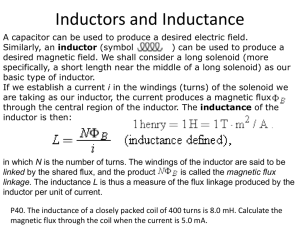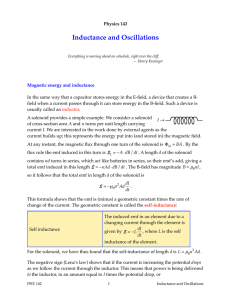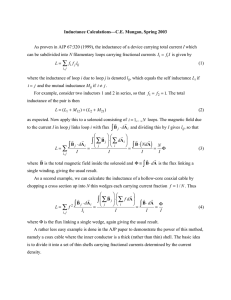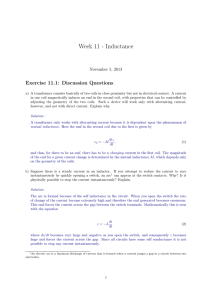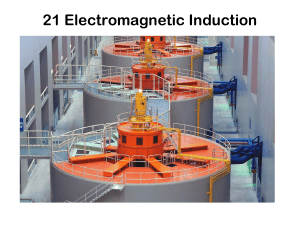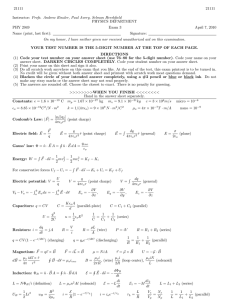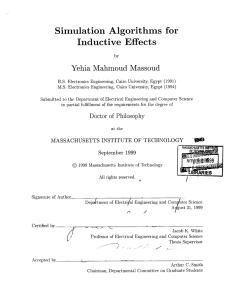Inductance and Inductors
advertisement
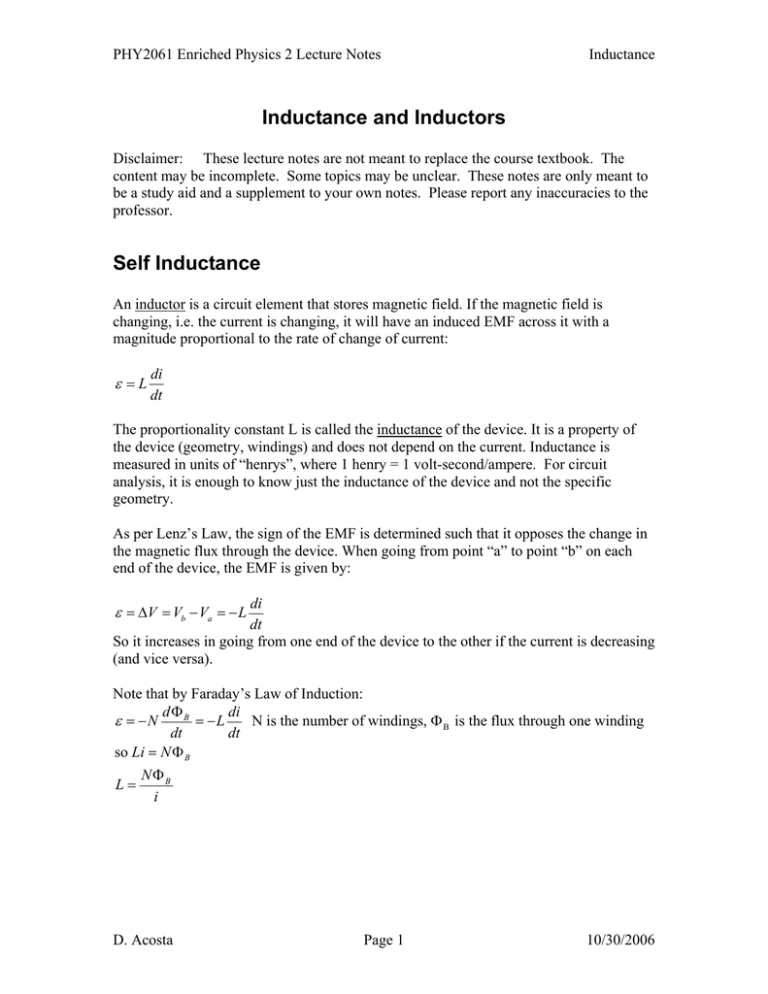
PHY2061 Enriched Physics 2 Lecture Notes Inductance Inductance and Inductors Disclaimer: These lecture notes are not meant to replace the course textbook. The content may be incomplete. Some topics may be unclear. These notes are only meant to be a study aid and a supplement to your own notes. Please report any inaccuracies to the professor. Self Inductance An inductor is a circuit element that stores magnetic field. If the magnetic field is changing, i.e. the current is changing, it will have an induced EMF across it with a magnitude proportional to the rate of change of current: ε =L di dt The proportionality constant L is called the inductance of the device. It is a property of the device (geometry, windings) and does not depend on the current. Inductance is measured in units of “henrys”, where 1 henry = 1 volt-second/ampere. For circuit analysis, it is enough to know just the inductance of the device and not the specific geometry. As per Lenz’s Law, the sign of the EMF is determined such that it opposes the change in the magnetic flux through the device. When going from point “a” to point “b” on each end of the device, the EMF is given by: di dt So it increases in going from one end of the device to the other if the current is decreasing (and vice versa). ε = ΔV = Vb − Va = − L Note that by Faraday’s Law of Induction: dΦB di ε = −N N is the number of windings, Φ B is the flux through one winding = −L dt dt so Li = N Φ B L= NΦB i D. Acosta Page 1 10/30/2006 PHY2061 Enriched Physics 2 Lecture Notes Inductance Examples Inductance of Solenoid For a solenoid, B = μ0 ni where n is the number of turns per unit length n = N . A di dt NΦB L= i ( nA )( BA) = ( nA )( μ0 ni )( A) = μ n 2 AA ⇒L= 0 i i L = μ0 n 2V ε = −L where V is the volume of the solenoid. Inductance of a Toroid For a toroid, B = μ0 Ni 2π r The magnetic field is perpendicular to the radius vector from the center of the circular toroid, thus it is parallel to the area vector through any radial slice across the toroid. Φ B = ∫ B ⋅ dA = ∫ BdA rb Φ B = ∫ Bhdr where h is the thickness of the toroid ra μ0 Ni r dr h 2π ∫r r ⎛r ⎞ μ Ni Φ B = 0 h ln ⎜ b ⎟ 2π ⎝ ra ⎠ ΦB = b a N Φ B μ0 N 2 h ⎛ rb ⎞ = L= ln ⎜ ⎟ i 2π ⎝ ra ⎠ Mutual Inductance (to be filled in) D. Acosta Page 2 10/30/2006 PHY2061 Enriched Physics 2 Lecture Notes Inductance Energy Stored in an Inductor Recall that the EMF is defined by ε = dW , the work done per unit charge by a source of dq EMF. dW dW dq = = ε i , and this is the power supplied by the source of EMF to dt dq dt maintain a current i. Power is P = This work applied by the EMF source is the negative of the work done by the magnetic field in setting up the EMF, and so this power directly changes the magnetic potential energy of the setup: W = ΔU , so dU P= dt For a circuit containing only an inductor, this EMF is given by ε = L di , so dt di dU = dt dt ⇒ dU = Lidi P = Li ⇒ U = ∫ Li′di′ U= 1 2 Li 2 This is the magnetic potential energy stored in an inductor. Contrast this to the electric 1 q2 2 potential energy stored in a capacitor: U = C ( ΔV ) = 2 2C Energy Density of a Magnetic Field Take the specific case of a solenoid: L = μ0 n 2V , so 1 B2 μ0 n 2Vi 2 = V 2 2μ0 The energy density (energy per unit volume) can be defined as: U= u= U B2 = V 2 μ0 D. Acosta Page 3 10/30/2006 PHY2061 Enriched Physics 2 Lecture Notes Inductance This is a general equation beyond just a solenoid and represents the energy density stored in a magnetic field. When combined with the electric field energy density, we have: 1 B2 2 u = ε0E + 2 2 μ0 Let’s compute the total stored energy in the solenoid used for the CMS experiment: B = 4T, r =3m, l = 13 m u= (4 T) 2 ( 4π 10 −7 2 Tm/A ) = 6.4 × 106 J/m3 The volume is V = π r 2 A = π ⋅ 32 ⋅13 = 368 m3 ⇒ U = 2.3 × 109 J (2.3 GJ!) This is the most stored energy of any constructed magnet. Note that 1 ton TNT equivalent is 4.2 × 109 J , so the energy stored in this magnet is equivalent to ½ ton TNT! One must be very carefully how this energy is dissipated… D. Acosta Page 4 10/30/2006

